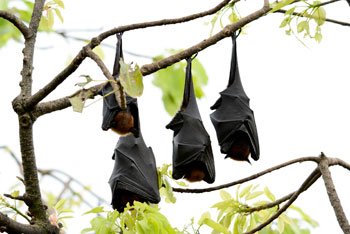 Feb. 19, 2014 – Insurance policies often include a “pollution exclusion clause,” which precludes coverage for damage caused by “pollutants.” Three recent cases illustrate the uncertainty of the law in this area.
Feb. 19, 2014 – Insurance policies often include a “pollution exclusion clause,” which precludes coverage for damage caused by “pollutants.” Three recent cases illustrate the uncertainty of the law in this area.
The cases don’t deal with “pollutants” in the chemical sense, but with “waste” in the “biological” sense. One involves bat guano that destroyed a home in northern Wisconsin. Two others involve the use of manure and septage used as farm fertilizer.
As the cases reveal, insurers and insured persons (and their lawyers) should understand, through clear policy language, what is and is not covered under pollution exclusions. Where ambiguities exist, the litigation result may differ by reviewing court.
Bat Guano is A Pollutant
In 2007, Joel and Evelyn Hirschhorn noticed a penetrating and offensive odor in their Lake Tomahawk vacation home in northern Wisconsin. Bat guano was the cause.
Bats had infiltrated their home’s siding and walls. After the uninhabitable home was demolished, their insurer declined coverage under the policy’s pollution exclusion.
The policy precluded coverage resulting from “pollutants,” defined as “any solid, liquid, gaseous or thermal irritant or contaminant, including smoke, vapor, soot, fumes, acids, alkalis, chemicals, liquids, gases and waste.” The operative term here was “waste.”
The Hirschhorns sued, claiming the home was a total loss and the pollution exclusion did not bar coverage because the policy did not contemplate “biological” waste.
Ultimately, in Hirschhorn v. Auto-Owners Ins. Co.,1 a Wisconsin Supreme Court majority concluded that bat guano unambiguously fell within the policy’s definition of “pollutant.”
 Stacy E. Ertz (William Mitchell, 1996) is a partner at Murnane Brandt, with offices in St. Paul, Minnesota, Hudson, Wisconsin, and Bismarck, North Dakota. She largely focuses her Wisconsin and Minnesota practices on insurance coverage litigation. Reach her by email or by phone at (651) 251-8309.
Stacy E. Ertz (William Mitchell, 1996) is a partner at Murnane Brandt, with offices in St. Paul, Minnesota, Hudson, Wisconsin, and Bismarck, North Dakota. She largely focuses her Wisconsin and Minnesota practices on insurance coverage litigation. Reach her by email or by phone at (651) 251-8309.
The supreme court majority found bat guano to be “waste” since the dictionary definition includes “the undigested residue of food eliminated from the body; excrement” and because the ordinary meaning of feces is “waste matter eliminated from the bowels.”
The court concluded that “waste” unambiguously includes feces and urine, rejecting any construction that limits the pollution exclusion to industrial or chemical-type operations.
The court also noted that a reasonable person in the insured’s position would understand bat guano to be waste. Accordingly, the Hirschhorn court held that bat guano fell within the policy’s definition of “pollutants” because feces, urine and the resulting odor, in any state, is a contaminant that may irritate skin and lungs.
The Hirschhorn ruling confirmed nearly twenty years of Wisconsin appellate decisions finding manure, guano, animal feces and human excrement constitute “pollutants.”2
Cow Manure Used For Fertilizer Is “Liquid Gold” and Not a Pollutant [District II]
Up through 2012, Wisconsin courts routinely found fecal matter to be a pollutant. In 2013, however, the District II Appeals Court concluded that a dairy farmer’s use of manure or “liquid gold” to fertilize farm fields was “a nutrient” and not a “pollutant.”
Farmers Robert and Jane Falk used manure to fertilize the fields on their dairy farm. But several neighbors alleged this practice polluted their water wells and aquifers. The Falks’ farmowner’s insurance policy precluded coverage for damage by “pollutants.”
Ultimately, the court of appeals in Wilson Mut. Ins. Co. v. Falk3 concluded that a “reasonable farmer” contemplating the policy would not view manure as “waste” or a “pollutant,” even though it contaminated neighboring water wells and a local aquifer.
The Falk court viewed the policy’s broad exclusion “as understood by a reasonable person in the position of the insured,” and held that a “reasonable farmer would not consider manure to be a ‘pollutant,’ an ‘irritant,’ a ‘contaminant,’ or ‘waste.’”
The court reasoned that manure is an “everyday expected substance on a farm” and does not become a pollutant merely because it may be harmful in high concentrations or unusual circumstances. “Manure is a matter of perspective,” the court noted.
“[W]hile an average person may consider cow manure to be ‘waste,’ a farmer sees manure as liquid gold,” the court wrote. The Falk court noted that an insurer issuing a farmowners’ policy cannot “seriously contend that paying claims related to the manure spreading is “a risk it did not contemplate and for which it did not receive a premium.”
Septage Used As a Farm Fertilizer Is a Pollutant
After finding, in Falk, that cow manure used to fertilize farm fields is not a pollutant under a farmowner’s policy, approximately one month later the District III Wisconsin Appeals Court reached a completely different conclusion in a farming septage case.
Dairy farmers Tina and Frederick Preisler had hired Kuettel Septic Service LLC to apply septage as a fertilizer at their farm in the early 2000s. Septage is a combination of water, urine, feces, chemicals, and other materials in septic tanks. In 2008, the Preislers’ farm experienced an algae bloom and suffered a large loss of cattle.
Testing revealed that the Preislers’ water well had elevated levels of nitrate due to over spraying of the septage on their farm fields. The Preislers sued Kuettel Septic Service, the Kuettel family, and others, alleging negligence caused the contaminated well.
Numerous insurers denied coverage of the Preislers’ claims, arguing that septage constituted “waste” under pollution exclusions. The circuit court agreed, concluding that septage was unambiguously “waste” and thus a pollutant under Hirschhorn.
Aligned in arguing that damages were covered by insurance, the Kuettels and Preislers appealed. But in Preisler v. Kuettel’s Septic Serv., LLC,4 the appeals court (per curiam) ruled that septage was a pollutant triggering the pollution exclusions based on Hirschhorn, which held that bat guano is unambiguously a contaminant.
The Preisler court, siding with the insurers, recognized that while “septage has beneficial uses, including as a fertilizer … substances should not be excluded from the definition of ‘waste’ simply because they have some potential beneficial uses.”
The court rejected the argument that under Falk, septage was not a pollutant according to the reasonable expectations of the farmer who used it to fertilize his fields.
In a footnote, the court found Falk inapplicable because: 1) the policy was unambiguous so the reasonable expectations of the insured need not be considered; and 2) the insureds were not similarly situated since a farmer [Falk] has different expectations than the insured [Kuettel] who was in the business of septage hauling, storage and disposal.
Author Analysis
If feces are unambiguously “waste,” as the Hirschhorn and Preisler courts ruled, shouldn’t “beneficial use” or “subjective intent” applications not apply?
How can water contamination due to the over spraying of septage in Preisler, or as a result of a ruptured manure pit in Norks (see footnote 2 below), both of which used feces as a fertilizer, be unambiguous pollutants in those cases, yet be considered “liquid gold” in Falk?
Can these decisions be reconciled in light of Hirschhorn’s ruling that bat guano is “waste” under its common, ordinary meaning and therefore an excluded pollutant?
These cases illustrate that pollution exclusions can be interpreted differently by different courts. Insurers (and their lawyers) should define what types of “biological” waste is not covered, and insureds (and their lawyers) must review such language closely.
Endnotes
1 Hirschhorn v. Auto-Owners Ins. Co., 338 Wis.2d 761, 774 (Wis. 2012).
2 See Norks v. Am. Family Mut. Ins. Co., 202 Wis.2d 648 (Wis. Ct. App. 1996) (District IV) (unpublished) (liquefied cow manure that leaked from a ruptured pit constituted “waste” under an unambiguous pollution exclusion and thus excluded clean-up costs for environmental damage); Guenther v. City of Onalaska, 223 Wis.2d 206 (Wis. Ct. App. 1998) (sewer water containing human waste that contaminated a basement was a pollutant and precluded recovery for odor damage only); Sharp v. Vick, 267 Wis.2d 277 (Wis. Ct. App. 2003) (unpublished) (suit alleging bodily injury from improper maintenance of shared water containing harmful bacteria, unfit for human consumption due to debris and wild animal feces, was not covered by policy containing a pollution exclusion since waste material includes animal feces, manure or urine).
3 Wilson Mut. Ins. Co. v. Falk, 2013AP691; 2013 WL 6480760 (Wis. Ct. App. 2013).
4 Preisler v. Kuettel’s Septic Serv., LLC, 2012AP2521, 2014 WL 114325 (Wis. Ct. App. 2014) (unpublished).
